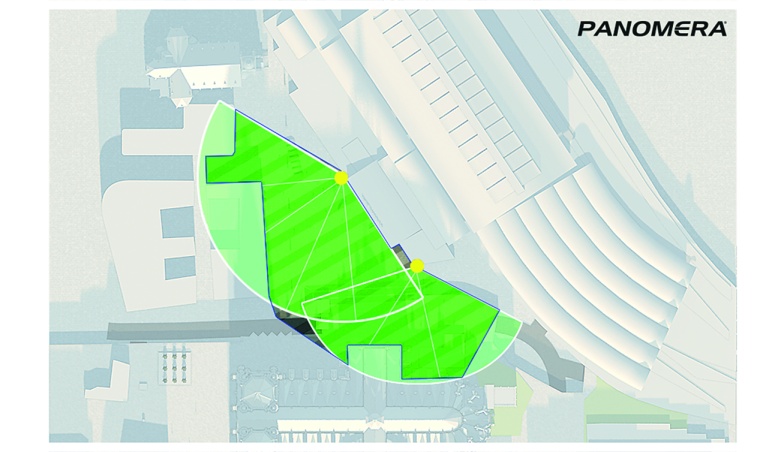Monitoring Public Spaces
As feelings of uncertainty are on the rise among the populace, demands to expand video surveillance installations and increase the number of cameras in public spaces are growing lo...



As feelings of uncertainty are on the rise among the populace, demands to expand video surveillance installations and increase the number of cameras in public spaces are growing louder, and are being voiced by representatives of all political affiliations.
But would more cameras or higher resolution cameras really offer more security? Regensburg-based manufacturer Dallmeier says no. And presents a viable alternative with its video solution for the city of Cologne.
The extraordinary technical capabilities of the company’s Panomera technology and its supporting system components initiate a shift in crime prevention. The Panomera multifocal sensor system was specially developed for the all-encompassing video surveillance of expansive areas. Broad widths, as well as areas at large distances, can be displayed with a completely new quality of resolution, in real time and at high frame rates of up to 30 fps. A huge area can be surveyed from a single location and, depending on the requirements of observation assignments, the resolution can be scaled almost limitlessly. So one Panomera equipped with eight sensors can be sufficient to replace 35 standard megapixel cameras.
Example Cologne
The events of New Year’s Eve 2015 in Cologne are seared into the memories of the entire population of the city. In the wake of countless incidents, including numerous cases of sexual harassment of women, Police recognized the need to revise their existing security concept, particularly with regard to securing large public spaces. A high number of criminal offences had been committed around Cologne Cathedral, and therefore this area of the inner city was selected as the basis for planning new security measures.
In Spring 2016, the first concepts were presented to the city administration. Their main focus was on how the situational overview for police, and therefore the deployment of police and other emergency personnel, could be improved through the use of video systems, especially in case of large gatherings. Even at those early stages of planning, the responsible officials encountered a massive problem: with the use of conventional video technology it would not have been possible to capture the entire 8,800 m² monitoring area. And there was no camera technology available which would have provided the resolution or pixel density required across the whole area for use in police investigations. Officials also realized that a conventional system comprised of numerous individual cameras would have resulted in a flood of data and images, which would significantly hamper proactive monitoring and quick reactions by the officers working in the control room.
Two Points
Dallmeier project experts were called upon to devise a feasible solution. After a short induction, they were able to design a system which would not only fulfill but, in fact, exceed the requirements. So the project was awarded to the Regensburg-based manufacturer and installation work for the Panomera system began in mid-December 2016. Instead of a system with numerous spread out cameras, which would have meant a complicated set-up as well as high infrastructure and maintenance costs, Dallmeier deployed a system that covers the entire monitoring area yet remains discreet. The solution required only two installation points so setting up the system was easy and the city will benefit financially from much lower infrastructure and maintenance costs compared to the original plans.
The protection of personal data is governed by extremely stringent laws in Germany. And police in Cologne are totally aware of their responsibilities when dealing with video data. Dallmeier has put in place a range of technical measures which will ensure that the data recorded with video cameras satisfies the strict requirements and regulations by which data privacy is protected. For example, certain zones in the image can be hidden entirely by the camera capture mechanism, or faces and car number plates can be rendered unrecognizable by pixelation. In addition, data retention is limited in time – long-term storage happens only when there are reasonable grounds for suspicion and a need for evidential material.
Active Monitoring vs. Passive Surveillance
Instead of simply having to assume that a large number of installed surveillance cameras would somehow bring about a significant reduction in criminality, police in Cologne are able to switch from ineffective passive surveillance to active video monitoring. Potentially dangerous situations are detected even before they threaten to become incidents in a police statistics report. Fast response forces are alerted rapidly and guided to the location of interest. And if a criminal offense is committed ‘under the noses’ of the police, Panomera supplies conclusive information which can be used as evidence in a court of law and as the basis for criminal investigations.
most read

GIT SECURITY AWARD 2026 - The winners have been announced!
GIT SECURITY AWARD 2026: The best safety and security solutions of the year - now an overview of all winners

Security management, building security & perimeter protection: the winners of category E at the GIT SECURITY AWARD 2026
GIT SECURITY AWARD 2026: Security management, building security & perimeter protection - an overview of the most innovative solutions


The Benefits of AI-based Video Surveillance Solutions for Sports Venues
Dallmeier Interview: Artificial intelligence Makes Stadiums Smarter










